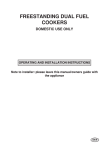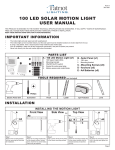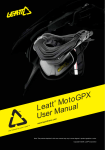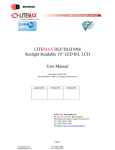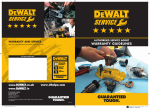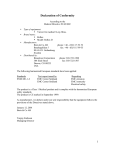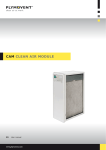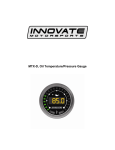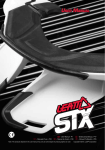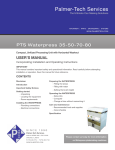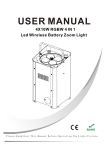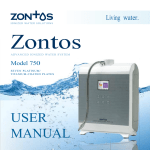Download Product Manual
Transcript
Contact details Head Office: No 50, Kiepersol Crescent, Atlas Gardens, Contermanskloof, Durbanville, 7550, Cape Town, South Africa Tel: +27 21 557 7257 Fax: +27 21 557 7381 Email: [email protected] Website: www.leatt.com Postal Address: Suite 109, Private Bag X3, Bloubergrant, 7443, South Africa USA: Tel: 661 287 9258 Toll Free: 1.800.691.3314 Fax: 661 287 9688 USER MANUAL Europe: 235-12 Email: [email protected] Copyright © 2013, Leatt® Corporation Copyright © 2013, Leatt® Corporation All motorsports are hazardous. USER MANUAL Leatt-Brace® MRX Participants can suffer severe brain, head, or neck injuries causing permanent paralysis or even death. A properly fitted Leatt-Brace®, worn in conjunction with a full-face helmet, can help reduce the incidence or severity of neck injuries, but no known safety device can eliminate the physical risks inherent in any motorsport activity. Read and follow all safety instructions A Leatt-Brace® is not a substitute for skill or experience. Do not attempt potentially hazardous maneuvers while wearing a Leatt-Brace® that you would not attempt without a brace. The Leatt-Brace® must be correctly fitted to the wearer’s body. Follow the sizing and fitment directions in this manual to ensure that your brace fits properly. Failure to achieve a correct fit of the Leatt-Brace® will reduce the effectiveness of the brace and may subject the wearer to unexpected risks. A cracked, bent, or deformed Leatt-Brace®, or any Leatt-Brace® worn by a user during an injury-producing accident or fall, should not be used again by anyone. Damage affecting the structural integrity and performance of the brace may not be visible to the naked eye. 01 Copyright © 2013, Leatt® Corporation Table of Contents • Instruction Manual Introduction ................................................. Page 03 • MRX parts and Components ..................................................... Page 04 • MRX fitment .............................................................................. Page 05 • Correct fitment .......................................................................... Page 06 • Set up the External Tether Helmet Mount ............................... Page 07 - 09 • Buckling up with your MRX ............................................. Page 09 • Releasing the harness with your MRX neck brace .................. Page 11 • Looking after your Leatt-Brace® ................................................ Page 12 • Indemnity and Warranty Disclaimer .......................................... Page 12 Copyright © 2013, Leatt® Corporation 02 MRX exploded view Instruction Manual Leatt-Brace® MRX This is a list of parts that might be mentioned in the manual and where they are situated. Spare parts are available. 9 10 8 Welcome to the world of Leatt® and thank you for choosing our product. The Leatt-Brace® you have purchased is based on years of academic research, extensive evaluation of the mechanisms of head and neck injuries, together with testing, both in test facilities and with simulation software. 12 11 7 6 5 Our design philosophy has always been to produce an effective neck injury prevention device with practical appeal, as determined by our test drivers. We will therefore always appreciate your feedback with regards to comfort and practicality for your chosen application of our product. We value your input, so please feel free to contact us on [email protected]. 4 13 3 14 This product has also undergone and passed SFI 38.1 which is a test standard evaluating the effectiveness of a Head and Neck Restraint (HNR) device. It utilises a dummy seated in a frontal test sled accelerated at 68G in order to generate high neck forces such as which may be found during an actual severe frontal crash. Neck tension/compression and the Neck Injury Criterion (Nij) are measured and evaluated against pre-determined injury threshold values. Two direct frontal (0deg) impacts and one side (30deg) impact is required for certification. 2 15 To ensure you utilize this product to its full potential please read the manual. If you have any other enquiries mail [email protected] or contact your closest dealer. 16 1 MRX Parts Parts/Components List 03 Copyright © 2013, Leatt® Corporation QTY Parts/Components List QTY 1 MRX Padding 1 9 Bookscrew 8x12mm 2 2 MRX Main Body 1 10 Helmet Pad 2 3 Front Rubbers 2 11 Tether 1 4 Post Anchor Backplate 2 12 Back Tether Unit 1 5 Post Anchor Frontplate 2 13 MRX Tether Attachment 2 6 Post Anchor Tab 2 14 Back Rubber 2 7 Countersunk Screw M6 x 20 2 15 Small Wing 2 8 Bookscrew 8x7mm 2 16 MRX Spanner 1 Copyright © 2013, Leatt® Corporation 04 MRX Fitment 1 First step is to get your MRX on, clear the tethers of the inside padding and place the two front wings on the side of your neck, pulling and flexing the MRX open if necessary. 3 Correct fitment Please make sure the MRX is always fitted correctly. If the MRX is not fitted correctly it might impede the brace’s functionality. 2 Proceed to pull the MRX forward until you feel the back of your lower neck hit the padding. The MRX Should always be in line with your neck and head. 4 ±90o Once you have the MRX on you can proceed to fit your helmet and attach the tether system ( please see p7). 05 Fit the right tether point over the right hook. Rotate the point towards the visor for ± 90o degrees and pull down. Repeat on the left sideside side. Copyright © 2013, Leatt® Corporation Make sure the MRX is positioned correctly on your shoulders, too far forward or back could create discomfort once you get in your seat. Copyright © 2013, Leatt® Corporation 06 CAUTION Two extra horizontal line markings The Leatt-Brace® MRX brace must be used with / installed on new generation safety/ racing helmets which come from the manufacturer with pre-drilled mounting holes (Helmet / Tether Terminals) for this type of equipment. All tightening of screws on the brace and its tether system should be maintained at a torque setting of 2Nm (18lbf-in) to ensure optimum effectiveness. 40mm from the rubber lining join the 2 centre points Validation of Pre-Drilled Hole Positioning: Leatt® recommends that you only use a new generation helmet with pre-drilled mounting holes (tether terminals). These terminals should be within a ±10mm (±3/8”) tolerance for proper and correct installation and use of the MRX brace. Helmets without tether terminals, or helmets with tether terminals that fall outside of the specified tolerance, cannot be used. 2. Mark your helmet’s horizontal line: Carefully join the 2 centre points to make the centre line of your helmet. Measure 40mm (~1 1/2”) from the top of the rubber lining & make the first horizontal mark. Now make 2 extra horizontal line markings on each side of your helmet. Keep measuring 40mm from the rubber lining for each of these markings. The following instructions are provided to allow you to verify that the existing Tether Terminals are located in the correct locations for proper and correct installation and use of your MRX brace. Follow steps 1 through 3 to determine if such tether terminals are within the ±10mm (±3/8”) tolerance necessary for proper and correct installation and use of your MRX brace. If the tether terminals are within the specified tolerance, continue with steps 4 through 8. mark the measure point 150mm (~6”) from the centre line centre line 3. Mark the tolerence center point for the mounting hole/Helmet-Tether-Terminal: Align your measuring tape from the centre line at the rear of your helmet & along the 2 marked horizontal lines. Measure 150mm (~6”) from the centerline; this is where your mounting hole (Helmet-Tether-Terminal) should be located. Repeat this step for the other side of your helmet. What you’ll need: • Your Helmet 2nd center point 2nd measurement from a fixed point measure from a fixed point 1st centre point masking tape • 4mm (~5/32”) Allen Key (supplied) • Leatt® Moto R Spanner (supplied) • Leatt® Tether System (supplied) • Masking Tape • Flexible Measuring Tape • Felt Tip Marker or Dark Pencil 1. Find your helmet’s centre: Apply masking tape to the rear of your helmet to prepare for markings. Use a flexible measuring tape & measure from an identical point on each side of the helmet. Calculate the half way point on the measuring tape & make your first mark. Now find your second centre point in the same way & mark above the first centre point. back plate front plate helmet inner padding helmet shell post anchor tab helmet-tetherterminal External Tether Helmet Mount 07 Copyright © 2013, Leatt® Corporation Leatt® tether end fitting Copyright © 2013, Leatt® Corporation capscrew M6 x 16mm 4. Assembling the External Tether Helmet Mount: Align the Back Plate underneath the Helmet Tether Terminal between the Padding & Shell. Fit the cap screw into the Post Anchor Tab that fits into the Front Plate. The remaining end of the cap screw must fit through the hole & must be screwed to the Back Plate using the supplied 4mm Allen Key. Make sure you do not over tighten as over tightening may crack and/or damage your helmet, which may compromise rider safety and helmet effectiveness. 08 3mm Allen Key Point Post Anchor Tab horizontally to back of helmet 5. Tightening the External Tether Helmet Mount: Slip the supplied 10mm (~3/8”) spanner between the padding & the shell. Now secure the spanner head over the Back Plate’s fixed nut. Tighten the cap screw (~2Nm (18lbf-in)), one full rotation, with the supplied 3mm Allen Key while securing the Back Plate’s fixed nut with the spanner. It is important to align the Post Anchor Tab horizontally & ensure that it points to the rear of the helmet. Buckling up with the MRX brace fitted: Do not over tighten. Belt Fitment in vehicle Before proceeding to with the belt fitment, please note that the MRX was designed to accomodate all seating angles. Ensure that the safety belts / multi-point harness are correctly installed in your vehicle. Belt adjusters should be set at the centre of the chest, below the side members of the MRX Race brace if possible and not at the base of your neck. This will assist in comfort and brace compatibility. 1. Assume a comfortable driving position once in your racing seat before tightening your safety harness. 2. Hold the safety harness over your shoulders. Run your hands forward over the belts while guiding them into the locating wings and side channel of the MRX brace. 3. Apply moderate tension to the belt adjusters and ensure that the harness runs through the wings and over the chest belt guides. 4. Now tighten the belts completely as you would normally do. There are wings on either side of the MRX (see Figure2), which are designed to accommodate the mandatory three-inch safety harness or optional 2-inch harness. These are belt guides and the belt must sit inside them. The belt guides are there to keep the belts away from soft tissue neck structures. This, together with the Side Tether design of the Leatt-Brace®, will help reduce the likelihood of neck injury in a side impact. The design of the MRX brace eliminates the need for harness padding sleeves. Hydration and communication lines may be routed via the safety belt. Figure 2 Seat Belt Belt positively located in wing 09 Belt adjusters in correct place over front wing the Belt should not go over the wing, if it exceeds the shoulder area let it curl up on the inside Copyright © 2013, Leatt® Corporation Copyright © 2013, Leatt® Corporation 10 Proper care and Maintenance Releasing the harness with the MRX brace fitted: Figure 3a Figure 3b Make it a habit to inspect your Leatt-Brace® as you would other safety equipment. Frequently worn braces should be discarded and replaced every three years. Do not make any alterations or modifications to your Leatt-Brace®. If you lose or damage adjustment pins, hinges, struts, padding, or other components, purchase replacements from Leatt®. Keep your Leatt-Brace® clean by washing it with plain soap and water. Solvents, abrasive cleaners, and high heat can damage the brace and reduce its effectiveness just when you need it the most. LIMITED WARRANTY 1. Release the harness at the buckle and grab the belts (see Figure 3a). Pull the safety harness in your forward direction. 2. Now, move the safety harness to your sides and in an upward and outward motion to ensure the belts are released from the wings on the MRX brace (see Figure 3b). YOUR LEATT-BRACE® IS WARRANTED TO BE FREE OF DEFECTS IN MATERIALS OR MANUFACTURING FOR ONE YEAR FROM THE DATE OF PURCHASE. THE LEATT-BRACE® IS DESIGNED TO YIELD OR BREAK UNDER CERTAIN CONDITIONS OF USE, SO DAMAGE CAUSED BY ACCIDENTS, FALLS, ABUSE OR MISUSE IS NOT COVERED BY THIS LIMITED WARRANTY. TO MAKE A WARRANTY CLAIM, GO TO WWW.LEATT.COM OR SEND AN EMAIL TO [email protected]. 3. With the harness located adjacent to your sides, you may now exit the vehicle. 4. We encourage you to practice getting in (ingress) and out of your vehicle (egress) with your Leatt-Brace® on. This Ingress and Egress practice will help you become more efficient on race day. LEATT CORPORATION EXPRESSLY DISCLAIMS ALL OTHER WARRANTIES, EXPRESS OR IMPLIED, INCLUDING THE WARRANTIES OF MERCHANTABILITY AND FITNESS FOR A PARTICULAR PURPOSE. In the event of a crash 1. Should your Leatt-Brace® be damaged as result of a serious accident, no Warranty Claim is possible. 2. Leatt® Corporation would like to hear from you if you have been involved in a crash event. The feedback is used to advance the understanding of crash dynamics in the Leatt® Lab and assist in improving our products. 3. In event of a crash, if you have supporting footage, photos or medical information, gather all the supporting information and submit it to the address below. 4. After evaluation by the Leatt® Lab and subject to the Leatt® Lab discretion incentives may be offered for fully completed Injury Assessment forms; You can fill in our online crash form at: www.leatt.com/customer-support/accident-form/ 11 Copyright © 2013, Leatt® Corporation Copyright © 2013, Leatt® Corporation 12 Notes Copyright © 2013, Leatt® Corporation Copyright © 2013, Leatt® Corporation









